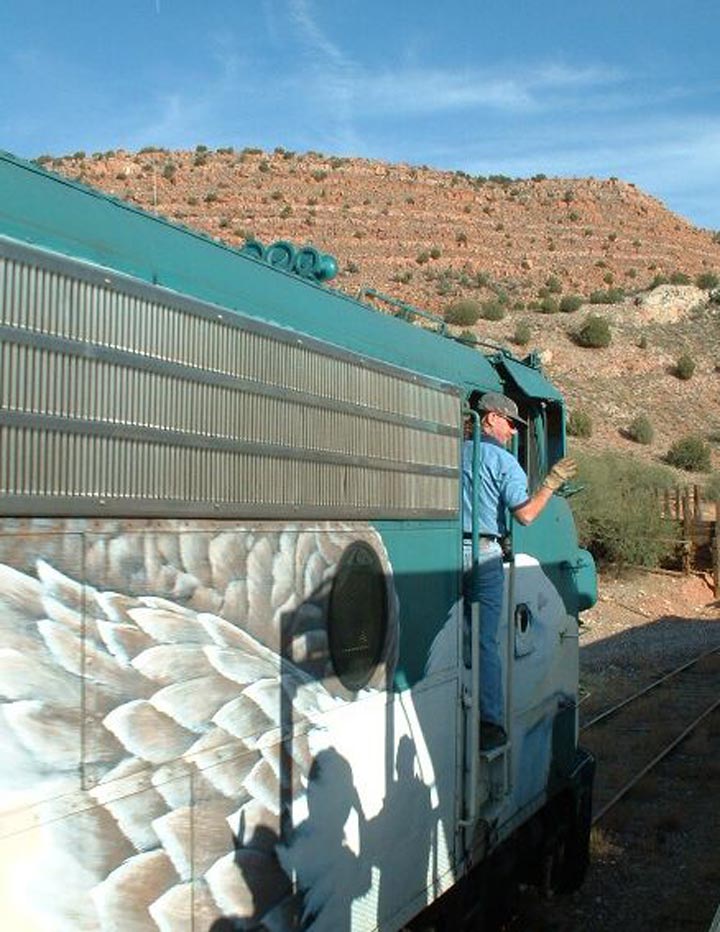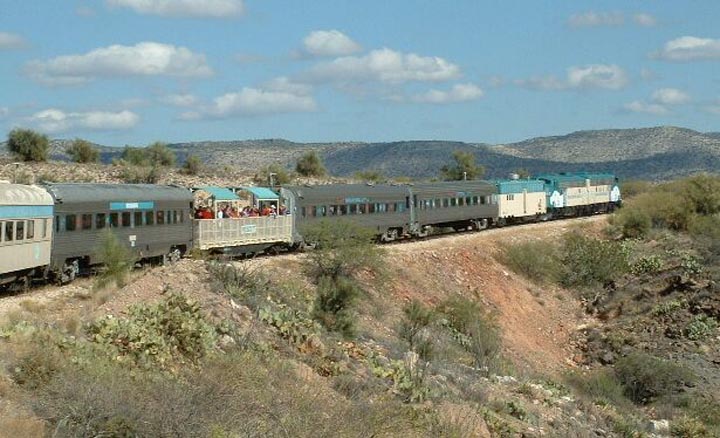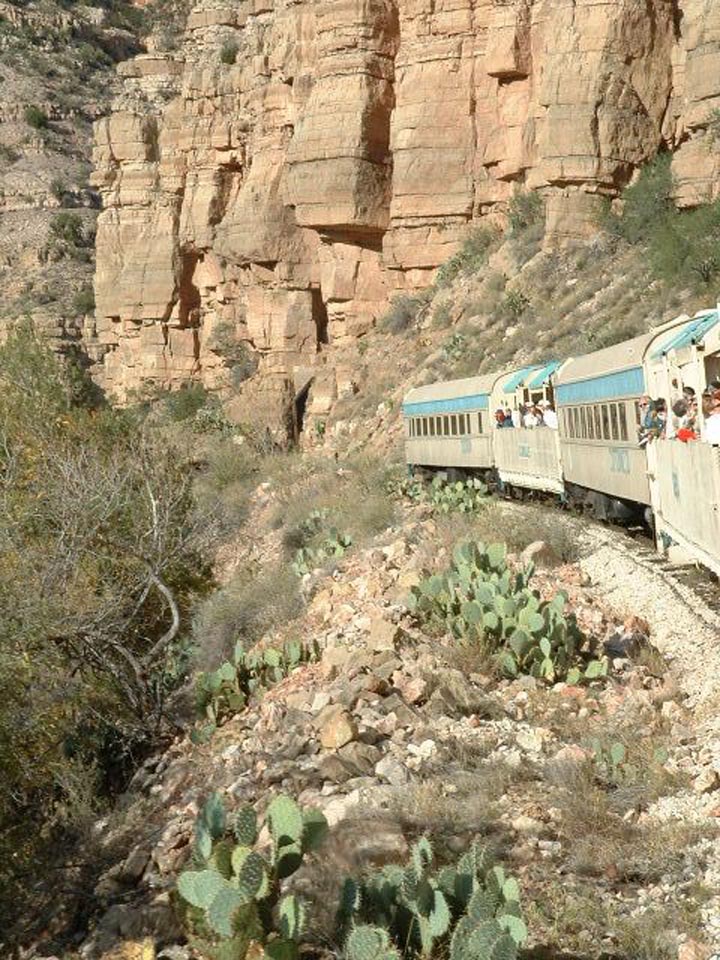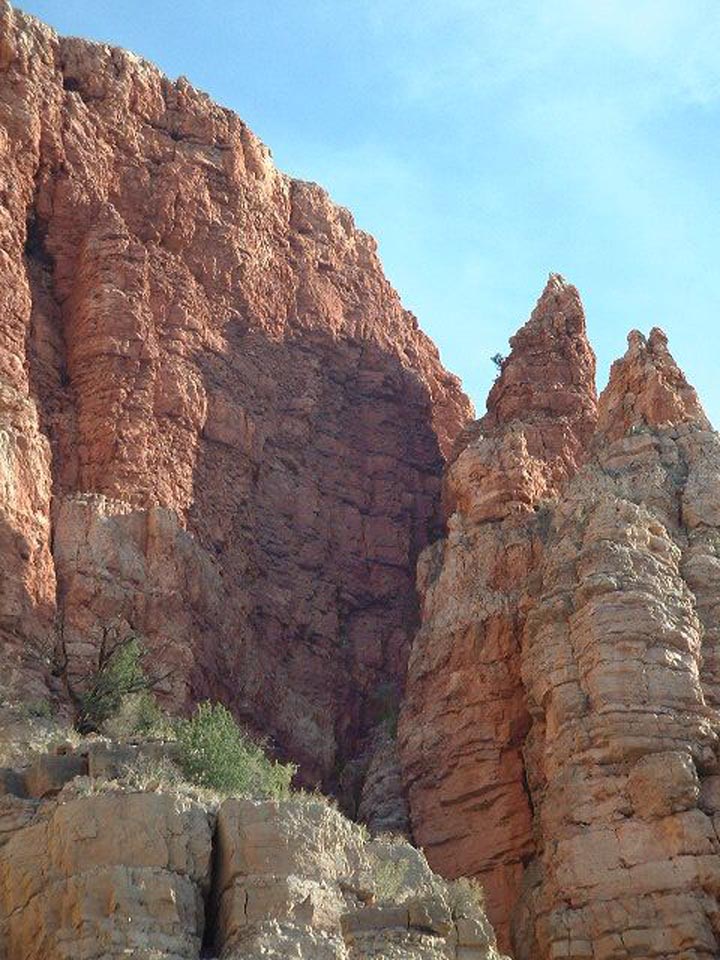Verde Canyon Railroad:–Rail Fanning in a Mining District
By Don Woodwell
While visiting the Grand Canyon recently, my wife and I happened upon a brochure describing the Verde Canyon Railroad (VCRR) excursion train. After riding the Grand Canyon Railway, my wife was not real keen on another train trip, but this one looked different. The train went along the bottom of a river canyon instead of overlooking it from a mile above. We asked around our Sedona (AZ) resort and learned that that the VCRR was at one time a supply train for a copper ore smelter that was mined in nearby Jerome. This was really beginning to sound interesting since I’d been planning to model a narrow gauge mining railroad.
Jerome was built at the site of a huge, rich copper deposit that was staked out in 1876, the town was named after its principal backer, Eugene Jerome. The town’s fortunes swung pendulum-like based on copper’s value for the next 77 years when the last mine and the Clarkdale smelter closed. It was in these times that railroading played a major role in copper mining and the development of Northern Arizona.
Driving southwest from Sedona, we headed down a long slope and in the distance across the Verde Valley we could see Jerome nestled high on the opposite mountains glistening in the bright morning sun. After visiting the Jerome State Historic Park (JSHP) we enjoyed a nice breakfast in the English Kitchen, one of the original Jerome restaurants (1899). The JSHP is the mansion built by James Douglas — owner of the Little Daisy Mine — and the nearby land. It’s filled with mining artifacts and geological dioramas depicting the location of the rich copper ore veins in the surrounding mountains.
It wasn’t until after we arrived in Clarkdale for the Noon departure of the VCRR excursion train, that I found Russell Wahmann’s(¹) book that described so well the huge engineering challenges that faced the Jerome railroad builders in the late 1800’s.
Trains transported copper ore to the Clarkdale smelter by standard gauge locos and ore cars, and Wahmann’s book inspires those of us who want to model mining operations such as these. Locomotives used on the Jerome to Clarkdale line include a three-truck Climax loco (unusual for a mining operation), a couple of ALCO 0-6-0s, and eventually two ALCO 2-6-6-2 Mallets that were purchased to handle the heavy ore car loads from the mine to the smelter.
We arrived at the VCRR’s modern, two story, southwestern-style depot with plenty of time to buy our tickets, browse the book store, and take train photos before we boarded one of the restored passenger cars. The train consists of both open and closed cars so you can either watch the scenery in deeply cushioned comfort or stand out on the open cars to take photos. We did both as our first class coach had a food and drink table that we couldn’t pass up. The tour guide on the open car had a continuous stream of colorful stories about Verde Canyon’s history, flora, and fauna especially the bald eagles that nest there. The Verde River flowing through the canyon is flanked with cottonwood trees giving it a green color almost year round, hence the Spanish description, “verde.”
In 1911, the Santa Fe started grading for the Verde Valley Railroad. This standard gauge, 38-mile line from Drake to Clarkdale to follows the twisting Verde River through the Verde Canyon for the 18 miles east from Perkinsville to Clarkdale. In some places, the river and the railroad share space only a few feet apart. A few miles east of Perkinsville, a relatively short but significant tunnel cuts through a sharp promontory. The new railroad enabled the United Verde copper mine to receive heavy materials for the new planned smelter at Clarkdale.
The railroad supported the mine smelter until operations petered out in 1953. By 1959, however, the railroad’s survival was ensured when the American Cement Company began operations. Initially, the plant supplied cement to the Glen Canyon Dam near Page, Arizona, but eventually it’s’ output was and still is fed into Phoenix to boost that city’s growth. The VVRR became the cement plant’s lifeline by supplying both coal and coke to feed the plant’s huge appetite for both raw materials. The plant’s limestone reserves are estimated at 150 years giving today’s VCRR a steady customer; and the base for long-term excursion service.
Dave Durbano of the Arizona Central Railroad purchased — sight unseen — the Verde Valley Railroad from the Santa Fe Railroad in 1988 based on its’ freight revenues. On Dave’s first trip through the Verde Canyon he was struck by the undisturbed wilderness and decided to add an excursion service to his freight line so that others would be able to appreciate the scenery and discover the line’s historical significance

The Verde Canyon trains are pulled by FP7 numbers 1510 and 1512 — only two of twelve that remains in North American service. The long story of the FP7s began in 1966 when they were first delivered to the Alaska Railroad. Later they serviced the Wyoming-Colorado Railroad. Trains consist of both Pullman Standard cars (1946-47 vintage) and stainless steel cars built by the Budd Company. The latter were once part of Santa Fe’s “El Capitan” route between Chicago and Los Angeles.
Twenty-three of the mileposts from Clarkdale (MP 38) to Perkinsville (MP 18.5) are highlighted in the official VCRR magazine(²) making it easy to pick out the more historical or spectacular scenes. The 40-mile round trip takes 3 ½ to 4 hours at a leisurely 12 mph. There are no paved roads into the canyon so the area is pristine, and taking the train is much less strenuous than the hiking alternative. Quite simply, riding the train is a comfortable way to get up close and personal, and enjoy the Verde Canyon’s natural beauty!
The line’s operating schedule accommodates the morning freight train that goes to Drake to pick up incoming raw materials for the cement plant. When our passenger train returned from Perkinsville, the freight was right behind it. After we stopped at the depot, the freight cars trundled past on their way to feed coal to the plant.
We met a lot of other fine folks who were rail fans like us. Some were out-of-towners or just local. We all felt that our day spent on the VCRR was great plain fun and very enjoyable!
References:
(¹) Wahmann, Russell, Verde Valley Railroads: Trestles, Tunnels, & Tracks, Jerome Historical Society, Jerome, AZ
(²) Rail: Official Magazine of the Verde Canyon Railroad, L.C., 300 N. Broadway, Clarkdale, AZ, 86324-2302








